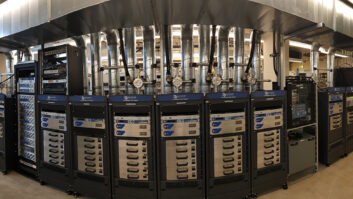Applied Technology: Vycon Flywheel Systems
Nov 9, 2012 2:00 PM, By Dann McKeraghan
While many things are changing in radio, one thing is certain. Electrical power is the lifeblood of broadcasting. A momentary glitch in power can result in dead air that pushes listeners to change stations – resulting in revenue reduction for advertisers and negatively impacting ratings. The challenge is that radio transmission systems are notoriously difficult to protect against power anomalies because of their sensitivity to even the smallest disruption. Analog and digital transmitters, audio consoles and networking systems all require clean, continuous power to operate at optimum levels.
Traditionally, these systems are protected by battery-based uninterruptible power systems (UPSs). These systems are effective in mitigating power interruptions and conditioning dirty power. However, broadcast engineers are finding that by adding flywheel energy storage in place of UPS’s lead-acid batteries, power reliability is significantly increased, green initiatives are advanced and total cost of ownership of the UPS systems are lowered.
UPS batteries are chemically based. This means that frequent battery maintenance, testing, cooling requirements, weight, toxic and hazardous chemicals and disposal issues are key concerns. One dead cell in a battery string can render the entire battery bank useless – not good when you’re depending on your power backup system to perform when you need it most. Every time the batteries are cycled, even for a split second, the more likely it is that they will fail the next time they are called upon.
A chemical-free alternative
Many broadcasters are depening on flywheel energy storage systems especially when energy efficiency, costs, space and environmental impact are concerns. This green technology is solving sophisticated power problems that challenge broadcasting operations every day. According to the Meta Group, the cost of downtime can average a million dollars per hour, so engineers can’t afford to take any risks. Flywheels used with three-phase double-conversion UPS systems provide reliable mission-critical protection against costly transients, harmonics, voltage sags, frequency deviations, spikes and total power failures.
How they work
Flywheel technology stores kinetic energy in a quiet, spinning disk to provide a reliable and predictable source of dc power. With recent advances that have made it more compact and able to support higher power applications, flywheel technology has emerged as a reliable, environmentally friendly power protection solution that stores energy mechanically instead of chemically – greatly enhancing dependability.

Figure 1. Cutaway of VYCON”s VDC Flywheel
A flywheel system replaces lead-acid batteries and works like a dynamic battery that stores energy kinetically by spinning a mass around an axis. It is designed for high power, short duration applications. Electrical input spins the flywheel rotor up to speed, and a standby charge keeps it spinning 24/7 until called upon to release the stored energy (See Figure 1). The flywheel hub is formed from aerospace-grade steel and a high-speed permanent magnet motor/generator, contact-free magnetic bearings that levitate 100 percent and sustain the rotor during operation. This allows the rotor hub to spin with no metal contact, eliminating bearing wear, bearing oiling or greasing or maintenance and no bearing replacements required for the life of the flywheel. What this means is a more reliable backup power solution. The flywheel can charge and discharge at high rates for countless cycles without degradation throughout its 20-year life – unlike traditional batteries. The amount of energy available and its duration is proportional to its mass and the square of its revolution speed. In the flywheel world, doubling mass doubles energy capacity, but doubling rotational speed quadruples energy capacity:
E = k M ?2
k – Depends on the shape of the rotating mass
M – Mass of the flywheel
? – Angular velocity
– continued on page 2
Applied Technology: Vycon Flywheel Systems
Nov 9, 2012 2:00 PM, By Dann McKeraghan
When used in conjunction with a UPS system (see Figure 2), flywheels provide uninterrupted dc ride-through power and voltage stabilization during brief utility power disruptions and brownout situations, Most backup generators require six to 10 seconds to come on-line and to connect with the UPS via the automatic transfer switch. Some flywheel units can provide up to 300kW of instant ride-through power and voltage stabilization for over 20 seconds (or other combinations of power and time) – more than enough time for the vast majority of electrical disturbances. Flywheel units can be paralleled for additional power capacity, run-time and/or redundancy.

Figure 2. Flywheel with UPS
Return on investment
When comparing the life cycle cost of batteries to flywheels (Figure 3), it’s clear which technology has a longer, sustainable cost savings over the life of the technology. What most engineers have discovered is that the flywheel has been favored over batteries due the cost savings in three to four years. However, it is important to know that the purchasing decision is not necessarily an either-or option since the flywheel can be used with or without batteries.

Figure 3. Relative lifecycle costs of flywheels versus batteries. Click to enlarge.
When used with batteries, known as battery hardening, the flywheel is the first line of defense against damaging power glitches because it absorbs all short-duration discharges – saving the batteries for prolonged power outages. As a result, the flywheel reduces the number and frequency of discharges, which shorten battery life. Because UPS batteries are the weakest link in the power-continuity scheme, flywheels paralleled with batteries give engineers peace of mind that their batteries are safeguarded against premature aging and unexpected failures. When the flywheel is used just with the UPS and no batteries, the system will provide instant power to the connected load exactly as it would do with a battery string. If the power event lasts long enough to be considered a hard outage – rather than just a transient outage – the flywheel will gracefully hand-off to the facility’s’ engine-generator.
Another strategic advantage to flywheels is that they can operate in harsh environments with no requirement for cooling. Also, today’s flywheels have very high uptime or availability due to their extremely infrequent maintenance needs. Occupying very little space, front access to the flywheel further eliminates space issues and opens up installation site flexibility in support of future operational expansions and rearrangements.
The flywheel gives broadcast engineers a more reliable and cleaner choice in protecting critical operations – increasing transmission reliability and the bottom line.
McKeraghan is vice president of Vycon, Cerritos, CA.
Harris Wins Illinois Governor’s Sustainability Award
The award recognizes ongoing environmental excellence for Harris, which implemented nine environmental impact reduction projects in 2011….
Radio Going Green
Read about ways radio broadcast stations and manufacturers are going green….












